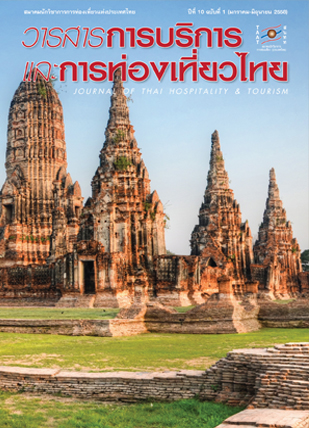Travel Behavior and Tourist Satisfaction of Foreign Tourists Affected Safety Journeys in Thailand
Main Article Content
Abstract
Tourism industry is a major source of revenues for Thailand. Although, the foreign tourists
have been increasing continuously but there is a threat to the quality of the journey in Thailand which
is the high level of risk on road safety. The urgent mitigation approach is needed to solve this highly
problematic. Thus, this study attempted to understand the behavior and satisfaction of foreign tourists which are the key information for a further recommendation of tourism promoting in the country. This study was collected data from 800 of a questionnaire to interview foreign tourists during their traveling by
selecting from the major tourist attractions with a high number of foreign tourists and a high accident rate.
The result of the study revealed that the travel information, road safety situation in the country, traffic
regulation and choice of transportations have an influence on accidental occurrences. Therefore, in order to
promote road safety in the country, foreign tourists need to change their attitude and travel behavior in
complying with road safety policy. Consequently, it will enhance road safety confidence to attract foreign tourists and finally reduce the risk of road accidents.
have been increasing continuously but there is a threat to the quality of the journey in Thailand which
is the high level of risk on road safety. The urgent mitigation approach is needed to solve this highly
problematic. Thus, this study attempted to understand the behavior and satisfaction of foreign tourists which are the key information for a further recommendation of tourism promoting in the country. This study was collected data from 800 of a questionnaire to interview foreign tourists during their traveling by
selecting from the major tourist attractions with a high number of foreign tourists and a high accident rate.
The result of the study revealed that the travel information, road safety situation in the country, traffic
regulation and choice of transportations have an influence on accidental occurrences. Therefore, in order to
promote road safety in the country, foreign tourists need to change their attitude and travel behavior in
complying with road safety policy. Consequently, it will enhance road safety confidence to attract foreign tourists and finally reduce the risk of road accidents.
Article Details
How to Cite
Iamtrakul, P., & al., et. (2015). Travel Behavior and Tourist Satisfaction of Foreign Tourists Affected Safety Journeys in Thailand. Journal of Thai Hospitality and Tourism, 10(1), 88–105. retrieved from https://so04.tci-thaijo.org/index.php/tourismtaat/article/view/35511
Section
Research Article
References
[1] กรมการท่องเที่ยว. (2555). ปัจจัยที่มีอิทธิพลต่ออุตสาหกรรมการท่องเที่ยว. กรุงเทพมหานคร:กระทรวงการท่องเที่ยวและกีฬา.
[2] กรมการท่องเที่ยว. (2556). สรุปสถานการณ์นักท่องเที่ยวชาวต่างชาติปี 2555. กรุงเทพมหานคร: กระทรวงการท่องเที่ยวและกีฬา.
[3] กรมส่งเสริมการปกครองท้องถิ่น. (2550). มาตรฐานการป้องกันอุบัติเหตุทางถนน. กรุงเทพมหานคร: กระทรวงมหาดไทย.
[4] กัลยา วานิชย์บัญชา. (2551). การวิเคราะห์ข้อมูลหลายตัวแปร. กรุงเทพมหานคร: โรงพิมพ์แห่งจุฬาลงกรณ์มหาวิทยาลัย.
[5] ฝ่ายเลขานุการ คณะกรรมการศูนย์อำนวยการความปลอดภัยทางถนน. (2554). แผนที่นําทางเชิงกลยุทธ์ทศวรรษแห่งความปลอดภัยทางถนน พ.ศ. 2554-2563. กรุงเทพมหานคร: กรมป้องกันและบรรเทาสาธารณภัย.
[6] ทวีศักดิ์ แตะกระโทก. (2555). แผนแม่บทความปลอดภัยทางถนนกรมป้องกันและบรรเทา. กรุงเทพมหานคร: ศูนย์วิชาการเพื่อความปลอดภัยทางถนน (ศวปถ.) มูลนิธิสาธารณสุขแห่งชาติ.
[7] สํานักงานคณะกรรมการพัฒนาการเศรษฐกิจและสังคมแห่งชาติ. (2555). แผนพัฒนาเศรษฐกิจและสังคมแห่งชาติ. กรุงเทพมหานคร: สํานักงานคณะกรรมการพัฒนาการเศรษฐกิจและสังคมแห่งชาติ.
[8] Allen, L. R., Long, P. T., Perdue, R. R. & Dieselbach, S. (1996). The impact of tourism development on the resident’s perception of community life. Journal of Travel Research, 27(1), 16-21.
[9] Cook, R. L. & McCleary, K. W. (1983). Redefining Vacation Distances in Consumer Minds. Journal of Travel Research, 38(1), 62-65.
[10] Elizabeth, K. & Cropper, M. (2003). Traffic Fatalities and Economic Growth. Washington: The World Bank Development Research Group Infrastructure and Environment.
[11] Host Communications, Inc. (1996). National Traveler Safety Team: Background and Goals. Lexington: Host Communications.
[12] Kantowitz, B. H., Hanowski, R. J. & Kantowitz, S. C. (1997). Driver acceptance of unreliable traffic information in familiar and unfamiliar settings. Human Factors, 39(1), 164–176.
[13] Krysan. (1965). Transportation: Past, Present, and Future. Dearborn: Henry Ford.
[14] Mendiratta, A. (2010). Taking Care of Tourists: Beyond Safety & Security. London: CNN’s TASK Group.
[15] Pond, K. L. (1993). The Professional Guide: Dynamics of Tour Guiding. New York: Van Nostrand Reinhold.
[16] Pond, K. L. (1993). The professional guide−The Traveller. New York: John Wiley and Sons. Inc.
[17] Robert, C. M. (1995). Tourism international business. Zurich: the Jacobs Foundation.
[18] World Tourism Organization (WTO). (1996). Tourist Safety and Security: Practical Measures or Destinations. Madrid, Spain: World Tourism Organization.
[19] World Health Organization. (2013). Global status report on road safety. Switzerland: Department of Violence and Injury Prevention and Disability.
[2] กรมการท่องเที่ยว. (2556). สรุปสถานการณ์นักท่องเที่ยวชาวต่างชาติปี 2555. กรุงเทพมหานคร: กระทรวงการท่องเที่ยวและกีฬา.
[3] กรมส่งเสริมการปกครองท้องถิ่น. (2550). มาตรฐานการป้องกันอุบัติเหตุทางถนน. กรุงเทพมหานคร: กระทรวงมหาดไทย.
[4] กัลยา วานิชย์บัญชา. (2551). การวิเคราะห์ข้อมูลหลายตัวแปร. กรุงเทพมหานคร: โรงพิมพ์แห่งจุฬาลงกรณ์มหาวิทยาลัย.
[5] ฝ่ายเลขานุการ คณะกรรมการศูนย์อำนวยการความปลอดภัยทางถนน. (2554). แผนที่นําทางเชิงกลยุทธ์ทศวรรษแห่งความปลอดภัยทางถนน พ.ศ. 2554-2563. กรุงเทพมหานคร: กรมป้องกันและบรรเทาสาธารณภัย.
[6] ทวีศักดิ์ แตะกระโทก. (2555). แผนแม่บทความปลอดภัยทางถนนกรมป้องกันและบรรเทา. กรุงเทพมหานคร: ศูนย์วิชาการเพื่อความปลอดภัยทางถนน (ศวปถ.) มูลนิธิสาธารณสุขแห่งชาติ.
[7] สํานักงานคณะกรรมการพัฒนาการเศรษฐกิจและสังคมแห่งชาติ. (2555). แผนพัฒนาเศรษฐกิจและสังคมแห่งชาติ. กรุงเทพมหานคร: สํานักงานคณะกรรมการพัฒนาการเศรษฐกิจและสังคมแห่งชาติ.
[8] Allen, L. R., Long, P. T., Perdue, R. R. & Dieselbach, S. (1996). The impact of tourism development on the resident’s perception of community life. Journal of Travel Research, 27(1), 16-21.
[9] Cook, R. L. & McCleary, K. W. (1983). Redefining Vacation Distances in Consumer Minds. Journal of Travel Research, 38(1), 62-65.
[10] Elizabeth, K. & Cropper, M. (2003). Traffic Fatalities and Economic Growth. Washington: The World Bank Development Research Group Infrastructure and Environment.
[11] Host Communications, Inc. (1996). National Traveler Safety Team: Background and Goals. Lexington: Host Communications.
[12] Kantowitz, B. H., Hanowski, R. J. & Kantowitz, S. C. (1997). Driver acceptance of unreliable traffic information in familiar and unfamiliar settings. Human Factors, 39(1), 164–176.
[13] Krysan. (1965). Transportation: Past, Present, and Future. Dearborn: Henry Ford.
[14] Mendiratta, A. (2010). Taking Care of Tourists: Beyond Safety & Security. London: CNN’s TASK Group.
[15] Pond, K. L. (1993). The Professional Guide: Dynamics of Tour Guiding. New York: Van Nostrand Reinhold.
[16] Pond, K. L. (1993). The professional guide−The Traveller. New York: John Wiley and Sons. Inc.
[17] Robert, C. M. (1995). Tourism international business. Zurich: the Jacobs Foundation.
[18] World Tourism Organization (WTO). (1996). Tourist Safety and Security: Practical Measures or Destinations. Madrid, Spain: World Tourism Organization.
[19] World Health Organization. (2013). Global status report on road safety. Switzerland: Department of Violence and Injury Prevention and Disability.


